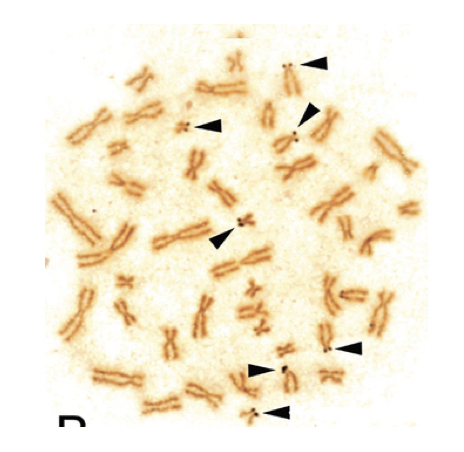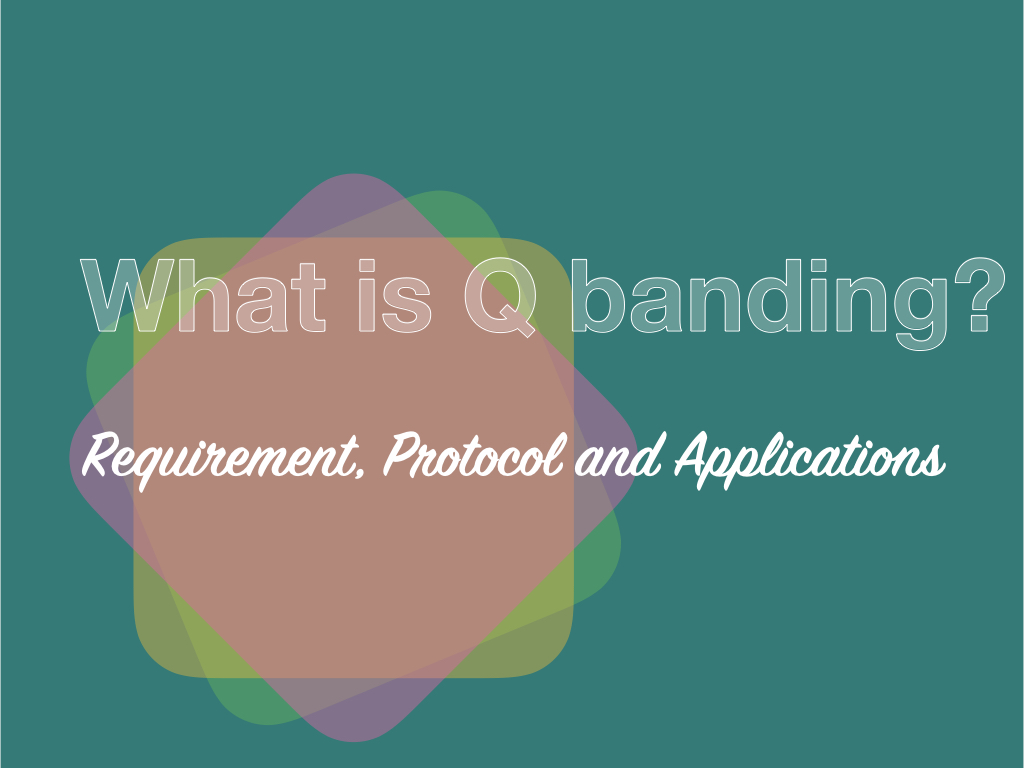NOR banding or nucleolar organizing region banding technique stains acrocentric chromosomes efficiently such as 13, 14, 15, 21 and 22.
Banding techniques are specialized procedures of chemical treatment and staining using various stains in order to study chromosomes. So far on this blog, we have explained many different banding techniques like GTG banding, QFQ banding, C banding, T banding and m banding.
All these techniques are used to stain and produce varied banding patterns for different assays. For example, The euchromatin and heterochromatin regions stain differently using G bands while a fluorescent set up is required to investigate QFQ banding.
NOR banding or N banding is yet another specialized banding technique, specially developed to stain those regions which have the nucleolar organizing regions.
Either silver nitrate or Ammoniacal silver are two methods commonly employed. Note that the NOR banding is so useful in detecting the Down syndrome- trisomy 21.
The present article explains to you what the nucleolar region is, how NOR banding is performed and what is its importance. Alongside, we will also explain the principle, process and common protocol for NOR banding.
What is NOR?
NOR stands for nucleolus organizer region and are important for the formation of the nucleolus of a cell. Two important ribosomal genes 18S and 28S rRNA genes of mammals are also located in this region only. 5.8S rRNA coding gene is also located here.
Notably, this specialized structure, the NOR is located on only a few chromosomes like 13, 14, 15, 21 and 22- all are acrocentric in nature. Genes like RNR1, RNR2, RNR3, RNR4 and RNR5 are located on chromosomes 13, 14, 15, 21 and 22, respectively.
The acrocentric chromosomes have a very short p arm and a long q arm, the NOR is situated on the short p arm, very close to the centromere. When stained, a distinct dark region gets visible only on acrocentric chromosomes.
Although the nature of genes isn’t well studied, still it might be tandem repeat copies.
At a molecular level, the NOR sequences have a definite location on short-armed chromosomes. The acrocentric chromosomes have a short p arm, which means, the telomere situated close to the centromere- the constitutive heterochromatin region.
The NOR-nucleolus organizer region is located between the telomere and constitutive heterochromatin regions. Note that, the bands of NOR can’t stain the centromere, those are NOR situated near it.
Read more: A karyotype of Klinefelter Syndrome- Explained.
NOR banding:
silver nitrate or Ammoniacal silver-based NOR banding are common techniques scientists use. The Ag-NOR- banding technique was developed by Matsui and Sasaki in 1973 and modified and improved by Goodpasture and Bloom in 1975.
To improve the accuracy, decrease the time and efficiency of the technique, varied modifications were done timely. Either chemical when used, stains specialized proteins located on NOR regions and visualized as darker spot.
Principle:
The base of NOR bands is to extract or digest the DNA, RNA and histone proteins, hence all the chromosomal constituents get digested, however, the region of acrocentric chromosomes near the constitutive heterochromatin region remain undigested due to the presence of non-histone proteins.
That non-histones of NOR stained darker and looks like one or two darker spots of different size.
This specialized structure is linked with the NOR and chromatin only but not with the gene body. There no other regions get stained.
Requirements:
Petri dish, slides and coverslips, pasture pipette, silver nitrate solution (store in dark water), distilled water, Fume hood, over, Ammonical silver, ammonium hydroxide and formalin.
Protocol:
NOR banding using silver nitrate:
- Prepare the 50% (5.0gm) silver nitrate solution, store it in a dark umber bottle and place it in the refrigerator.
- Take a Petri dish and place a wet tissue paper or paper towel in it.
- Place the pre-aged slides (or instructed by experts) in the Petri dish, apply a few drops of silver nitrate solution and cover it with a coverslip.
- Incubate at 37°C for 24 hours in dark- avoid light exposure.
- The next day, wash the slide with water, dry it and stain it with Giemsa solution.
- Caution: avoid skin contact with silver nitrate, it is corrosive and may burn skin.
NOR banding using ammoniacal silver:
- Place a few drops of silver nitrate, cover it with a coverslip and allow to heat the slides at 60°C for few minutes. Heating leads to the crystalization of silver nitrate.
- Wash the slide with distilled water and remove the coverslip (do not touch the coverslip directly, can burn skin).
- Soon after, place a few drops of formalin solution and ammoniacal silver on the slide and cover it with coverslip again.
- It is very important to observe the staining procedure, to do so first observe slides under the low power of microscope if you are satisfied with the results (-visibly developed golden brown color).
- Wash the slide with water, allow it to dry and observe under a microscope in high power.
- High caution: formalin is corrosive, toxic, mutagen and carcinogen, avoid skin contact, inhalation, swallow. It may cause cancer or burn skin.

Karyotypic mosaicism and molecular cytogenetic markers in the scleractinian coral Acropora pruinosa Brook, 1982
Applications of NOR banding:
The present technique is exclusively employed to investigate and study the NOR- nucleolar organizing regions present on different chromosomes, however, either technique has its own importance.
For example, the Ag-NOR-banding can distinguish active and inactive NORs. The silver staining technique can only stain the active (transcriptionally active) NOR regions, which means, highly recommended to distinguish active and non-active NOR regions.
NOR banding is often applicable to investigate and study the acrocentric chromosomes.
Trisomy 21 can be encountered effectively using the present technique.
Other chromosomal aberrations such as Robertsonian translocation chromosomal rearrangements of acrocentric chromosomes can be studied by combining the NOR with G banding or FQF banding.
Limitations:
The significant limitation of the NOR technique is that it can’t be used to investigate all types of chromosomes, as it can only stain the acrocentric NOR regions.
The technique is time-consuming.
Chemicals and solutions used in the present technique can burn skin, irritate or cause serious problems like cancer.
Extensive care must be taken to handle, prepare and store chemicals.
Additional recommendations:
NOR banding is an easy and simple technique to stain chromosomes, however, care must be taken while performing. The researcher should have to observe slides manually in order to decide the dose of staining.
The technique becomes more aggressively useful when combined with other techniques like G banding or G banding.
To investigate trisomy 21, the NOR banding is one of the best choices. It can even clear the idea when stained with Giemsa along with silver nitrate.
Note that no exact standardized protocol for the present technique is available, one has to optimize it as per the requirement.
In addition, regions other than NOR can be stained light yellow, henceforth, it can’t be well performed, darker yellow-colored regions may be observed.
To avoid redundancy in results, wash slides thoroughly until a light yellow color is visible along with a dark spot near the centromeric regions of the acrocentric chromosomes.
Other banding techniques: Q-Banding, C-Banding, T-Banding.
Conclusion:
Studies suggest that the protein stained by silver are ribonucleic protein complexes that surround the NOR region. Silver impregnates in only active cistronic regions or NOR.
Still, if you want to study only Down syndrome, one can use the present technology as a confirmatory one. If you wish to use the exact protocol, chemical preparation and concentration of each chemical, you can download our NOR banding brochure or our ebook when available.


